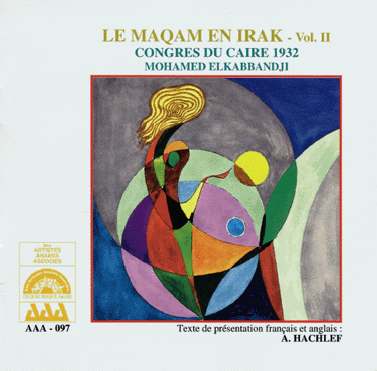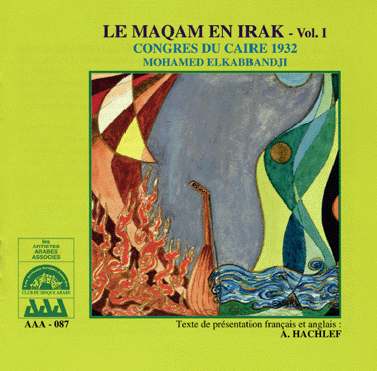|
Iraq |
Iraq
 |
|
Club du disque Arabe - AAA 087 |
Club du disque Arabe - AAA 097
P. 1994 |
Records of Arabian Music
Maqam in Iraq Vol.1 & 2
The International Congress of Arabian Music in Cairo in 1932:
Mohammed Elqabbandji
The form taken in Iraq by the sawt of hidjaz
is the maqam which is the most perfect and
noblest form the learned music of that country
can offer. The maqam is performed by one
singer (the qari) and three musicians who
play respectively the santur (similar to a
mediaeval dulcimer i.e. psaltery struck by
mallets), the djoza (spike fiddle) and the
tabla or tombak (a double drum). To
constitute the djalghi baghdadi of nuba
ensemble another kind of drum is added : a
riqq- the drumhead of which is stretched over
a wooden frame-. The principal part
characteristic of the maqam is a poem written
in one of the sixteen varieties of classical
metres either in literary Arabic or in colloquial
language. In the latter case the poem is called
zuhairi.
The maqam, the tradition of which has lasted
in Iraq for nearly four centuries, has been
transmitted orally by the Iraqi masters in an
uninterrupted chain between past and present.
The singer improvises melodic passages
making freely use of different rhythms while
passing progressively from one region of the
chosen mode to another. Displaying all his
virtuosity and flexibility of voice he reaches the
acme of the maqam; then leaves it
imperceptibly and comes to the final note of
the mode after having embroidered musical
phrases, all of them proofs of his talent and
inventiveness
The maqam starts with the tahrir often
preceded by an instrumental introduction
called badwa and composed on a
well-defined rhythm; the singer accompanies
the badwa passing alternately from
high-pitched notes to low-pitched ones. The
tahrir is made of one or more songs, the texts
of which may be extended by one or two
Arabic, Persian or Turkish interjections added
by the singer when the texts of the songs prove
too short with regard to the improvised
melody. The maqam ends with the taslim or
taslom which is a text set to a falling melodic
passage ending with the final note of the scale
of that maqam. Between the tahrir and the
taslim there are a series of melodic passages
of variable length which are performed
alternately by the singer and the musicians
and which develop in turn the different regions
of the scale.
The artists who interpret maqam-s are
considered to be autorities on the matter of
repertoire; they know all about it and are
famous for the specific way in which they
interpret a given maqam. Some of them are
famous for the passages they have added to
certain maqam-s, others for the composing of
whole maqam-s with a view of enriching the
already rich repertoire.
A concert when only maqam-s are played is
called a fasl. In such a fasl the maqam-s
are always played in the same order and the
fasl is named after the first maqam of the
series. The Iraqi repertoire offers five fasl-s :
bayat - hidjaz - rast - nawa and
husseini. At the end of every maqam the
orchestra plays a pesté which is a piece of
music composed in the same mode as the
maqam. This device allows the singer to rest
before the beginning of the next maqam. In
former times it was usual to play several fasl-s
on a musical evening.
Among the masters of the maqam who have
carried on its musical tradition, generation
after generation, and whose names are still
known nowadays, we will mention: Mulla
Hassan Babudidji (1782-1840) and his pupil
Ramallah Shiltag who taught a whole
generation of artists, the most famous of whom
were Ahmed Zaidan and Mulla Osman
Almussili. Many artists of the following
generation have Ahmed Zaidan to thank for
their musical talent and their fame, for
instance Rashid Kandardji (deceased in 1963)
and Abbas Chikhali. Among the next
generation we will qote the great master
Mohammed ElQabbandji who was born in
1901 and considered the greatest of his time for
the register of his voice as well as for the
precision of his interpretation of the traditional
maqam. Endowed with a vast memory, he
had memorized a great number of poems,
which allowed him to sing what was fit in all
circumstances. He was sent to the International
Congress of Arabian Music in Cairo in 1932, as
a representative of Iraqi music. Many of his
interpretations were recorded on that occasion,
which gives us an opportunity to hear them
nowadays. We have also come across music
played by Abbas Chikhali and recorded at the
same period but its commercial success has
been rather limited. What is recorded here is
all the more valuable as it is nearly
unavailable. The companies that released
those masters' records do not exist any longer.
The extant recordings have been taken care of
miraculously by the BBC Record Library and
put at our disposal since we have undertaken to
save the musical heritage of the Arab World in
our Anthology of Arabian music.
October 1991
after «Anthologie de la musique arabe»
published by Publisud - Paris. Translated by M. Stoffel
Adapted for the web by Lars Fredriksson with the kind
permission of the author Amin Hachelaf.
Copyright remains with the author!
